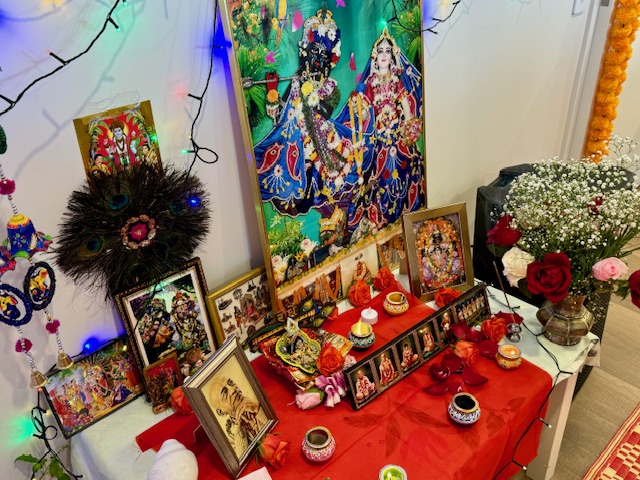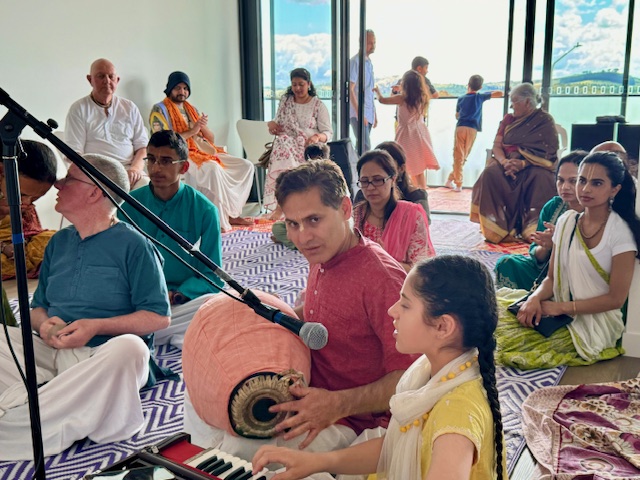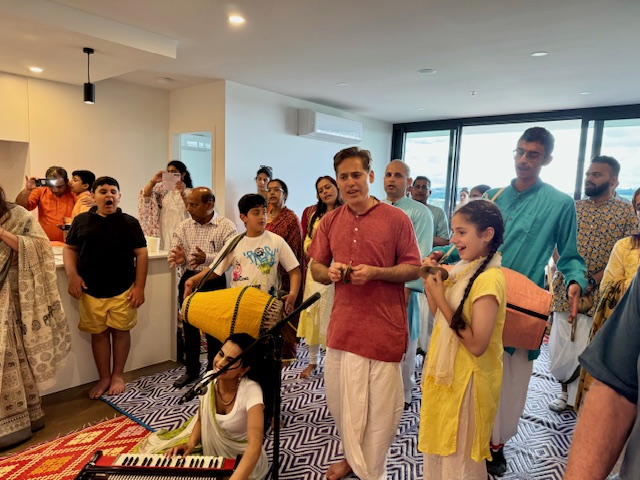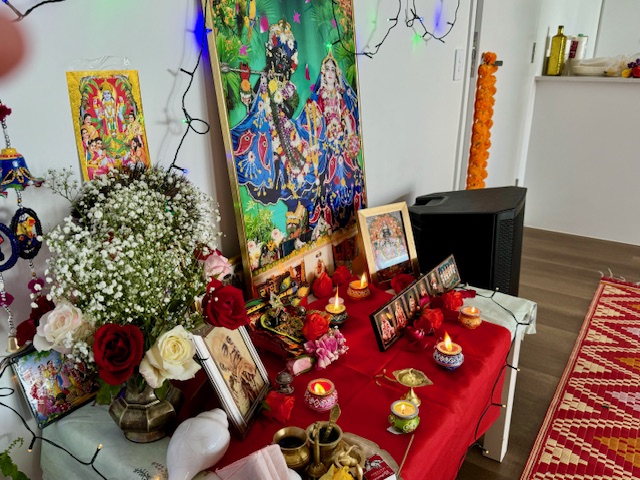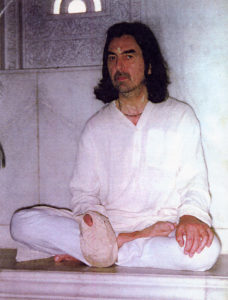The 11th day of the waning phase of the Moon (Krishna Paksha) in the month of Margashirsha (November–December) is observed as Utpanna Ekadasi. It is believed that fasting on this Ekadasi relieves one from the reactions to sins of past and present lives. This day is also known as Uttpatti Ekadasi.
The narration below of the story of Utpanna Ekadasi, while rather long, reveals the incredible benefits of observing Ekadasi, from the lips of Sri Krishna Himself to Arjuna, as well as why this Ekadasi is the origin of the Ekadasi fast in general, and the identity of Ekadasi Devi.
It’s recommended to chant extra rounds and stay up all night chanting and hearing the Lord’s glories. It is also auspicious to donate to Vaishnavas and Lord Krishna’s service on Ekadasi. We invite our readers to take advantage of this auspicious day and donate towards the completion of the Nrsimhadeva Wing, scheduled to open during the 2024 Gaura Purnima Festival from February 29 – March 2. Please go to the Give To Nrsimha 2023 Fundraiser page TODAY and help complete this offering to the Lord.
Suta Goswami said, “O learned brahmanas, long ago Lord Sri Krishna, the Supreme Personality of Godhead, explained the auspicious glories of Sri Ekadasi and the rules and regulations governing each observance of fasting on that holy day. O best of the brahmins, whosoever hears about the origins and glories of these sacred fasts on the Ekadasi days goes directly to the abode of Lord Vishnu after enjoying many different kinds of happiness in this material world.
“Arjuna, the son of Pritha, asked the Lord, ‘O Janardana, what are the pious benefits of complete fasting, eating only supper, or eating but once at midday on Ekadasi, and what are the regulations for observing the various Ekadasi days? Kindly narrate all this to me’.
“The Supreme Lord Krishna replied, ‘O Arjuna, in the beginning of winter (northern hemisphere), on the Ekadasi that occurs during the dark fortnight of the month of Margasirsha (November-December), a novice should begin his practice of observing a fast on Ekadasi. On Dasami, the day before Ekadasi, he should clean his teeth nicely. Then during the eighth portion of Dasami, just as the Sun is about to set, he should eat supper.
‘The next morning the devotee should make a vow, according to the rules and regulations, to observe fasting. At midday he should bathe properly in a river, lake or small pond. A bath in a river is most purifying, that taken in a lake is less so, and a bath in a small pond is the least purifying. If neither a river, lake nor pond is accessible, he may bathe with well-water.
‘The devotee should chant this prayer containing the names of Mother Earth: “O Asvakrante! O Rathakrante! O Vishnukrante! O Vasundhare! O Mrttike! O Mother Earth! Kindly remove all the sins I have accumulated throughout my many past lives so that I may enter the sacred abode of the Supreme Lord.” ‘As the devotee chants, he should smear mud over his body. During the day of fasting the devotee should not speak to those who are fallen from their religious duties, to dog-eaters, to thieves, or to hypocrites. He should also avoid speaking with slanderers, with those who abuse the demigods, the Vedic literatures, or brahmanas, or with any other wicked personalities such as those who have sex with forbidden women, those who are known plunderers, or those who rob temples. If any such person is spoken to or even seen during Ekadasi, one must purify oneself by looking directly at the sun.
‘Then the devotee should respectfully worship Lord Govinda with first-class food, flowers, and so forth. In his home he should offer the Lord a lamp in pure devotional consciousness. He should also avoid sleeping during the daytime and should completely abstain from sex. Fasting from all food and water, he should joyfully sing the Lord’s glories and play musical instruments for His pleasure throughout the night. After remaining awake all night in pure consciousness, the worshipper should give charity to qualified brahmanas and offer his humble obeisances unto them, begging their forgiveness for his offences.
‘Those who are serious about devotional service should consider the Ekadasis that occur during dark fortnights to be as good as those that occur during bright fortnights. O king, one should never discriminate between these two kinds of Ekadasis.
‘Please listen as I now describe the results obtained by one who observes Ekadasi in this way. Neither the merit one receives by taking a bath in the sacred place of pilgrimage known as Sankhoddhara, where the Lord killed the Sankhasura demon, nor the merit one receives upon seeing Lord Gadadhara directly is equal to one sixteenth of the merit one obtains by fasting on Ekadasi. It is said that by giving charity on a Monday when the moon is full, one obtains a hundred thousand times the results of ordinary charity. O winner of wealth, one who gives charity on the day of the sankranti (equinox) attains four hundred thousand times the ordinary result. Yet simply by fasting on Ekadasi one obtains all these pious results, as well as whatever pious results one gets at Kurukshetra during an eclipse of the sun or moon. Furthermore, the faithful soul who observes complete fasting on Ekadasi achieves a hundred times more merit than one who performs an Asvamedha-yajna (horse sacrifice). One who observes Ekadasi just once earns ten times more merit than a person who gives a thousand cows in charity to a brahmana learned in the Vedas.
‘A person who feeds just one brahmacari earns ten times more merit than one who feeds ten good brahmanas in his own house. But a thousand times more merit than is earned by feeding a brahmacari is achieved by donating land to the needy and a respectable brahmana, and a thousand times more than that is earned by giving away a virgin girl in marriage to a young, well- educated, responsible man. Ten times more beneficial than this is educating children properly on the spiritual path, without expecting any reward in return. Ten times better than this, however, is giving food grains to the hungry. Indeed, giving charity to those in need is the best of all, and there never has been or ever will be a better charity than this. O son of Kunti, all the forefathers and demigods in heaven become very satisfied when one gives food grains in charity. But the merit one obtains by observing a complete fast on Ekadasi cannot be measured. O Arjuna, best of all Kurus, the powerful effect of this merit is inconceivable even to the demigods, and half this merit is attained by one who eats only supper on Ekadasi.
‘One should therefore observe fasting on Lord Hari’s day either by eating only once at midday, abstaining from grains and beans; or by fasting completely. The processes of staying in places of pilgrimage, giving charity, and performing fire sacrifices may boast only as long as Ekadasi has not arrived. Therefore, anyone afraid of the miseries of material existence should observe Ekadasi. On Ekadasi one should not drink water from a conch-shell, kill living entities such as fish or pigs, or eat any grains or beans. Thus, I have described to you, O Arjuna, the best of all methods of fasting, as you have inquired from Me.’
“Arjuna then asked, ‘O Lord, according to You, a thousand Vedic sacrifices do not equal even one Ekadasi fast. How can this be? How has Ekadasi become the most meritorious of all days?’
“Lord Sri Krishan replied, ‘I will tell you why Ekadasi is the most purifying of all days. In the Satya-Yuga there once lived an amazingly fearsome demon called Mura. Always very angry, he terrified all the demigods, defeating even Indra, the king of heaven, Vivasvan, the sun-god, the eight Vasus, Lord Brahma, Vayu, the wind-god, and Agni, the fire-god. With his terrible power he brought them all under his control.
‘Lord Indra then approached Lord Shiva and said, “We have all fallen from our planets and are now wandering helplessly on the earth. O lord, how can we find relief from this affliction? What will be the fate of us demigods?’ ‘Lord Shiva replied, “O best of the demigods, go to that place where Lord Vishnu, the rider of Garuda, resides. He is Jagannatha, the master of all the universes and their shelter as well. He is devoted to protecting all souls surrendered to Him.’
“Lord Krishna continued, ‘O Arjuna, winner of wealth, after Lord Indra heard these words of Lord Shiva, he proceeded with all the demigods to the place where Lord Jagannatha, the Lord of the universe, the protector of all souls, was resting. Seeing the Lord sleeping upon the water, the demigods joined their palms and, led by Indra, recited the following prayers: “O Supreme Personality of Godhead, all obeisances to You. O Lord of lords, O You who are praised by the foremost demigods, O enemy of all demons, O lotus-eyed Lord, O Madhusudana (killer of the Madhu demon), please protect us. Afraid of the demon Mura, we demigods have come to take shelter of You. O Jagannatha, You are the doer of everything and the creator of everything. You are the mother and the father of all universes. You are the creator, the maintainer, and the destroyer of all. You are the supreme helper of all the demigods, and You alone can bring peace to them. You alone are the earth, the sky, and the universal benefactor. You are Shiva, Brahma, and also Vishnu, the maintainer of the three worlds. You are the gods of the sun, moon, and fire. You are the clarified butter, the oblation, the sacred fire, the mantras, the rituals, the priests, and the silent chanting of japa. You are the sacrifice itself, its sponsor, and the enjoyer of its results, the Supreme Personality of Godhead. Nothing within these three worlds, whether moveable or immovable, can exist independent of You. O Supreme Lord, Lord of lords, You are the protector of those who take shelter of You. O supreme mystic, O shelter of the fearful, please rescue and protect us. We demigods have been defeated by the demons and have thus fallen from the heavenly realm. Deprived of our positions, O Lord of the universe, we are now wandering about this earthly planet.”
“Lord Krishna continued, ‘Having heard Indra and the other demigods speak these words, Sri Vishnu, the Supreme Personality of Godhead, replied, “What demon possesses such great powers of delusion that he has been able to defeat all the demigods? What is his name, and where does he live? Where does he get his strength and shelter? Tell Me everything, O Indra, and do not fear.”
‘Lord Indra replied, “O Supreme Godhead, O Lord of lords, O You who vanquish the fear in Your pure devotees’ hearts, O You who are so kind to your faithful servants. There was once a powerful demon of the Brahma dynasty whose name was Nadijangha. He was extraordinarily fearsome and wholly dedicated to destroying the demigods, and he begot an infamous son named Mura.
“Mura’s great capital city is Chandravati. From that base the terribly evil and powerful Mura demon has conquered the whole world and brought all the demigods under his control, driving them out of their heavenly kingdom. He has assumed the roles of Indra, the king of heaven, Agni, the fire-god, Yama, the lord of death, Vayu, the wind-god, Isha, or Lord Shiva, Soma, the moon-god, Nairrti, the lord of the directions, and Pasi, or Varuna, the water-god. He has also begun emanating light in the role of the sun-god and has turned himself into the clouds as well. It is impossible for the demigods to defeat him. O Lord Vishnu, please kill this demon and make the demigods victorious.”
‘Hearing these words from Indra, Lord Janardana became very angry and said, “O powerful demigods, all together you may now advance on Mura’s capital city of Chandravati.” ‘Encouraged thus, the assembled demigods proceeded to Chandravati with Lord Hari leading the way
‘When Mura saw the demigods, that foremost of demons started roaring very loudly in the company of countless thousands of other demons, who were all holding brilliantly shining weapons. The mighty-armed demons struck the demigods, who began abandoning the battlefield and fleeing in the ten directions. Seeing the Supreme Lord Hrsikesha, the master of the senses, present on the battlefield, the furious demons rushed toward Him with various weapons in their hands. As they charged the Lord, who holds a sword, disk, and club, He immediately pierced all their limbs with His sharp, poisonous arrows. Thus, many hundreds of demons died by the Lord’s hand.
‘At last the chief demon, Mura, began fighting with the Lord. Mura used his mystic power to render useless whatever weapons the Supreme Lord Hrsikesa unleashed. Indeed, to the demon the weapons felt just like flowers striking him. When the Lord could not defeat the demon even with various kinds of weapons – whether those that are thrown or those that are held – He began fighting with His bare hands, which were as strong as iron-studded clubs. The Lord wrestled with Mura for one thousand celestial years and then, apparently fatigued, left for Badarikashrama. There Lord Yogeshvara, the greatest of all yogis, the Lord of the universe, entered a very beautiful cave named Himavati to rest. O Dhananjaya, winner of wealth, that cave was ninety-six miles in diameter and had only one entrance. I went there out of fear, and also to sleep. There is no doubt about this, O son of Pandu, for the great fight made me very tired. The demon followed Me into that cave and, seeing Me asleep, started thinking within his heart, “Today I will kill this slayer of all demons, Hari.”
‘While the wicked-minded Mura was making plans in this way, from My body there manifested a young girl who had a very bright complexion. O son of Pandu, Mura saw that she was equipped with various brilliant weapons and was ready to fight. Challenged by that female to do battle, Mura prepared himself and then fought with her, but he became very astonished when he saw that she fought him without cessation. The king of the demons then said, ‘Who has created this angry, fearsome girl who is fighting me so powerfully, just like a thunderbolt falling upon me?’ “After saying this, the demon continued to fight with the girl.
‘Suddenly that effulgent goddess shattered all of Mura’s weapons and in a moment deprived him of his chariot. He ran toward her to attack her with his bare hands, but when she saw him coming she angrily cut off his head. Thus, the demon at once fell to the ground and went to the abode of Yamaraja. The rest of the Lord’s enemies, out of fear and helplessness, entered the subterranean Patala region.
‘Then the Supreme Lord woke up and saw the dead demon before Him, as well as the maiden bowing down to him with joined palms. His face expressing His astonishment, the Lord of the universe said, “Who has killed this vicious demon? He easily defeated all the demigods, Gandharvas, and even Indra himself, along with Indra’s companions, the Maruts, and he also defeated the Nagas (snakes), the rulers of the lower planets. He even defeated Me, making Me hide in this cave out of fear. Who is it that has so mercifully protected Me after I ran from the battlefield and went to sleep in this cave?”
‘The maiden said, “It is I who have killed this demon after appearing from Your transcendental body. Indeed, O Lord Hari, when he saw You sleeping he wanted to kill You. Understanding the intention of this thorn in the side of the three worlds, I killed the evil rascal and this freed all the demigods from fear. I am Your great Maha Sakti, Your internal potency, who strikes fear into the hearts of all Your enemies. I have killed this universally terrifying demon to protect the three worlds. Please tell me why You are surprised to see that this demon has been killed, O Lord.” ‘The Supreme Personality of Godhead said, “O sinless one, I am very satisfied to see that it is you who have killed this king of the demons. In this way you have made the demigods happy, prosperous, and full of bliss. Because you have given pleasure to all the demigods in the three worlds, I am very pleased with you. Ask any boon you may desire, O auspicious one. I will give it to you without a doubt, though it be very rare among the demigods.”
‘The maiden said, “O Lord, if You are pleased with me and wish to give me a boon, then give me the power to deliver from the greatest sins that person who fasts on this day. I wish that half the pious credits obtained by one who fasts will accrue to one who eats only in the evening (abstaining from grains and beans), and that half of this pious credit will be earned by one who eats only at midday. Also, may one who strictly observes a complete fast on my appearance day, with controlled senses, go to the abode of Lord Vishnu for one billion kalpas after he has enjoyed all kinds of pleasures in this world. This is the boon I desire to attain by Your mercy, my Lord, O Lord Janardana, whether a person observes complete fasting, eats only in the evening, or eats only at midday, please grant him a religious attitude, wealth, and at last liberation.”
‘The Supreme Personality of Godhead said, “O most auspicious lady, what you have requested is granted. All My devotees in this world will surely fast on your day, and thus they will become famous throughout the three worlds and finally come and stay with Me in My abode. Because you, My transcendental potency, have appeared on the eleventh day of the waning moon, let your name be Ekadasi. If a person fasts on Ekadasi, I will burn up all his sins and bestow upon him My transcendental abode. These are the days of the waxing and waning moon that are most dear to Me: Tritiya (the third day), Ashthami (the eighth day), Navami (the ninth day), Chaturdasi (the fourteenth day), and especially Ekadasi (the eleventh day). The merit one attains by fasting on Ekadasi is greater than that achieved by observing any other kind of fast or by going to a place of pilgrimage, and even greater than that achieved by giving charity to brahmanas. I tell you most emphatically that this is true.”
‘Having thus given the maiden His benediction, the Supreme Lord suddenly disappeared. From that time onward the Ekadasi day became most meritorious and famous all over the universe. O Arjuna, if a person strictly observes Ekadasi, I kill all his enemies and grant him the highest destination. Indeed, if a person observes this great Ekadasi fast in any of the prescribed ways, I remove all obstacles to his spiritual progress and grant him the perfection of life.
‘Thus, O son of Prtha, I have described to you the origin of Ekadasi. This one day removes all sins eternally. Indeed, it is the most meritorious day for destroying all kinds of sins, and it has appeared in order to benefit everyone in the universe by bestowing all varieties of perfection. One should not discriminate between the Ekadasis of the waxing and waning moons; both must be observed, O Partha, and they should not be differentiated from Maha-Dvadasi. Everyone who fasts of Ekadasi should recognize that there is no difference between these two Ekadasis, for they comprise the same tithi.
‘Whoever completely fasts on Ekadasi, following the rules and regulations, will achieve the supreme abode of Lord Vishnu, who rides upon Garuda. They are glorious who devote themselves to Lord Vishnu and spend all their time studying the glories of Ekadasi. One who vows not to eat anything on Ekadasi but to eat only on the next day achieves the same merit as one who executes a horse sacrifice. Of this there is no doubt.
‘On Dvadasi, the day after Ekadasi, one should pray, “O Pundarikaksha, O lotus-eyed Lord, now I will eat. Please shelter me.” After saying this, the wise devotee should offer some flowers and water at the Lord’s lotus feet and invite the Lord to eat by chanting the eight-syllable mantra thrice. If the devotee wants to gain the fruit of his fast, he should then drink water taken form the sanctified vessel in which he offered water at the Lord’s lotus feet.
‘On Dvadasi one must avoid sleeping during the day, eating in another’s home, eating more than once, having sex, eating honey, eating from a bell-metal plate, eating urad-dal, and rubbing oil on one’s body. The devotee must give up these eight things on Dvadasi. If he wants to speak to an outcaste on that day, he must purify himself by eating a Tulasi leaf or an amalaki fruit. O best of kings, from noon on Ekadasi until dawn on Dvadasi, one should engage himself in taking baths, worshipping the Lord, and executing devotional activities, including the giving of charity and the performance of fire sacrifices. If one finds himself in difficult circumstances and cannot break the Ekadasi fast properly on Dvadasi, one can break it by drinking water, and then one is not at fault if he eats again after that.
‘A devotee of Lord Vishnu who day and night hears these all-auspicious topics concerning the Lord from the mouth of another devotee will be elevated to the Lord’s planet and reside there for ten million kalpas. And one who hears even one sentence about the glories of Ekadasi is freed from the reactions to such sins as killing a brahmana. There is no doubt of this. For all eternity there will be no better way of worshiping Lord Vishnu than observing a fast on Ekadasi.’
Thus ends the narration of the glories of Margasirsa-krsna Ekadasi, or Utpanna Ekadasi, from the Bhavisya-uttara Purana.
Sri Radha sat in a beautiful forest grove among Her many girl friends, looking like the vibrant moon surrounded by twinkling stars. They were laughing with one another, seeking shelter from the hot afternoon sun, under the benevolent, wish-fulfilling trees of Vrindavan. The gopis, the maidens of the village of Vrindavan looked to their princess, Sri Radha and spoke.
“Oh Radha, beautiful, gentle-natured, lotus eyed daughter of King Vrishabhanu, please tell us what vow we may follow to attain the favor of Sri Krishna.”
At the mention of Krishna’s name Radha bent Her head shyly, a crimson blush blooming gently across Her cheeks. The Prince of Vraja was the hero of every young girl’s heart, the gopis included. It was no secret that although every maiden, young and old, ran to Krishna, He ran to Radha. They knew that there must have been some secret to the hold that She had over the charming gopa and they yearned to know how they too could possibly catch his attention. They would do anything, take up any austerity, pray to any God, and endure any hardship if it meant that their Krishna would be pleased with them.
“Radhe, You have made Krishna, whom even great demigods like Brahma and Mahadeva cannot approach, just like Your submissive servant!”
Sri Radha covered Her face with the gauzy fabric of Her veil, momentarily humbled by their praise. After a heartbeat, She recovered Her composure and with a sweet, compassionate smile the goddess who accepted the role of a simple milkmaid in the transcendental village of Vraja, spoke to Her assembly of friends.
“To attain Sri Krishna’s mercy you should follow the vow of fasting on Ekadasi. In that way you will make the Lord into your submissive servant. Of this there is no doubt.” The gopis looked at their princess with rapt attention. They hung on to Her every word as She described to them the vow which would grant them the perfection of their lives. Sri Radha held up Her hand as She instructed Her friends to listen carefully. The eleventh day of each waxing and waning lunar cycle was reserved as a fasting day where one voluntarily took on penance to please the Supreme Lord, but it also held the story of a compassionate goddess.
With a wide smile which shone like sun rays from the brilliant sun of Sri Radha’s face, She began: “During the waning moon, the dark fortnight, of the month of Margasirsa, in order to kill the demon Mura, the divine goddess Ekadasi Devi was born from the body of Lord Vishnu.”
Indra, king of the heavens, along with all of the other celestial demigods approached the shore of the milk ocean and Svetadvipa, the effulgent island which was home to the Supreme Lord Vishnu along with the goddess Lakshmi. This place was their safe haven, and the assembled demigods could feel their fears and anxieties washing off of them just as the waves from the ocean of milk receded from the shore of the ethereal Island. Indra was sure that the Lord would be able to help them, and with that faith, he put forth his appeal.
“Oh Lord of the universe, oh Supreme Personality of Godhead, we offer our respectful obeisances to you.” Indra paused to close his eyes and touched his forehead to his joined palms in salutation. All of the accompanying devas followed, offering Lord Vishnu their respects.
“You are the creator, maintainer, and destroyer, of this entire cosmic manifestation. You are the mother, father, and the supreme shelter of everyone.” Indra glanced back and the dejected look of the other demigods who were in trouble gave him the strength to continue. Indra extended his arms in supplication to the Lord who was his only savior.
“Although it may appear as though we are controllers of the many universal affairs, actually, we are merely Your servants, put into our positions by You. We are always subordinate to You, our master, and are forever dependent on Your abundant grace. You are the Supreme Person! You are the protector of surrendered souls who rely on Your shelter just as the beautiful pearls of Your necklace rest on Your broad chest. Oh Supreme Mystic, the demigods have been driven out of our heavenly kingdom and have lost our home. We were ousted by a cruel and vicious demon and have fled to the Earth Planet. We are now plunged into an ocean of miseries without our kingdom. We beg for Your aid! Lord, be pleased with us!” Indra was aware that with each plea, his voice rose and became more and more urgent.
On hearing such a pathetic prayer from the king of the devas, Lord Vishnu began to understand their dire situation. In a deep voice that seemed to come from everywhere all at once, He spoke to Indra. “Who is this invincible demon who has defeated even the demigods? What is his name and what is the source of his prowess? Please explain everything to Me in detail. Do not fear.” Lord Vishnu held His right hand up to Indra to give him the encouragement to speak, His soft, red palm facing the demigods and blessing them with fearlessness.
Indra took a breath feeling instantly relieved. “There is a fierce demon named Mura. The great city of Chandravati is the capital of this horrible being, but he has now taken over our capital city of Amaravati and we have been unable to withstand his attacks. Not has he overtaken our city, but he is living in our palaces and has even dared to take over the post of some of the most important devas like Agnideva, Yamaraja and Varuna. He has rendered us ineffective. Although we have all joined forces, it has been impossible to defeat him. Completely exhausted and with no other recourse, we have come to You. You are our only hope.”
Lord Vishnu’s soft smile vanished. His eyes looked intense and His gracefully curved eyebrows drew close together in annoyance. He cast a grave and sober glance over all of the demigods. When the Lord’s beautiful eyes, usually so full of love, came to rest on Indra again, the king of the heavens could see the fire blazing behind them. The Lord was angry.
“My dear Indra, do not worry. I will personally kill this enemy of yours. All of you should travel along with Me to the city of Chandravati.”
The demigods released a collective sigh of relief and gratitude and all at once, they raised their clasped palms above their heads and murmured chants of thanks to the Lord who would once again come to their rescue.
The demigods, rejuvenated by the presence of Lord Vishnu marched on the city of Chandravati to do battle once again with Mura and his army of demons. The Lord defeated the demon horde, dispersing them as if they were nothing more than a swarm of gnats. However, when He engaged in battle with Mura himself, the Supreme Lord used various weapons but the demon refused to die.
Finally, Lord Vishnu engaged in hand to hand combat, wrestling with the demon for ten thousand years. Their blows sounded like the planets themselves were being crushed into powder, but the battle raged on and on, the devas watching with bated breath, hoping that their Lord would bring and end to their suffering soon.
Overcome by the punishing blows of the Supreme Lord, Mura was defeated and lay unconscious on the blood-stained battlefield. Feeling tired, Lord Vishnu left Mura and the battlefield and journeyed to Badarikasrama high in the Himalayas to rest. Once in Badarikashrama, He entered a beautiful cave called Hemavati and laid down. He entered a deep slumber, His beautiful lotus eyes closing against the fatigue He felt from fighting so long with the demon.
Suddenly, the demon Mura who had regained consciousness shortly after Lord Vishnu departed for the ashrama, followed the Lord to His resting place and entered the cave. It was dark and quiet inside the cave, but Mura could easily see the effulgent form of Lord Vishnu. Seeing his opponent sleeping so peacefully, the demon smiled evilly. This would be the perfect opportunity to put an end to Vishnu who had destroyed all of his plans and many of his demon soldiers, not to mention countless demon rulers before him. Raising a sword, which glinted menacingly in the reflected light from the Lord’s many jewels and shining armor, Mura could almost taste victory as he brought it down with a swoosh!!
Mura was momentarily blinded by a fierce, bright light which was almost as hot as it was intense. The light lit up every corner of the cave, but Mura was not to be deterred. He pressed forward with the edge of his sword thinking this to be another trick of that crafty Vishnu, but no matter. There was nothing that would defeat him. As the light dimmed, Mura glanced down to see Vishnu with his eyes still closed, resting just as peacefully as he had been before. The demon’s eyes widened as he wondered who or what it was that was currently stopping him. He looked up and into the furious face of a woman.
The brightness of her form was still illuminating the inside of the cave. She had dazzling armor and was holding a sword firmly against the one he brought down to behead the savior of the demigods. She had various weapons, but it seemed as though the longer Mura looked at her to try and decipher all of the details of his opponent the brighter her effulgence became until it was too painful to try and look directly at her. No matter, whoever it was, Mura would do battle with them, and he would win. He would stop at nothing until he killed Vishnu.
Time was lost to both the demon and the warrior goddess as they fought, the clang of their swords relentlessly echoing off of the inner walls of the cave, but Vishnu never stirred. Finally Mura raised his sword high above his head, ready to deliver a death blow to the goddess, but she was quicker than the demon, and with blurring speed, her sword slashed through the air with and Mura’s head rolled at her feet while his body was suspended in motion, freezing for a moment in his last battle stance before crumpling to the floor of the cave in a lifeless heap.
The goddess stood back and gazed at the sleeping form of her beautiful Lord with folded hands. His eyes opened, and her eyes dropped to the ground before her, overcome with shy reverence. Lord Vishnu looked at the beautiful woman who stood before Him. She had a beautiful face with what the Lord knew were wide lotus eyes even as she glanced down and away from Him. A golden crown adorned her head and her black hair hung free in waves that flowed around her. She had many weapons which she held at rest, but her sword was dripping with blood. Lord Vishnu followed the trail of blood and saw the body of the demon Mura lying, forgotten on the floor of Hemavati cave. Astonished, Lord Vishnu looked toward the goddess again.
“Devi, who are you?” His tone was gentle and she looked up at him timidly, but in her eyes was the unmistakable courage and competence of a born warrior.
“My Lord, I am born from Your very own body, the moment this demon raised his sword to kill You. I have killed this wretched demon who sought to kill You as he saw You sleeping.” She cast one last fierce glance at the demon before returning her gaze back to the Lord. A beautiful smile curved onto His lips.
“Oh goddess, I am very pleased with you. Please ask for any benediction you desire.” Vishnu looked at the beautiful girl waiting to hear her desire.
“Oh my Lord, if You are pleased with me and wish to give me a boon, then just as You have allowed me to protect You who protects the entire universe, with my very essence, by laying waste to this sinful demon, please give me the power to deliver any person who honors me on this day by eradicating any and all of their greatest sins.” The goddess smiled once she asked for the benediction which immediately brought joy to her heart.
“So be it, Devi. You are My spiritual energy. Since you have appeared on this day of Ekadasi, your name shall be Ekadasi Devi. Anyone who follows the vow of Ekadasi, honoring you, will be relieved from all sinful reactions and attain inexhaustible heavenly and transcendental happiness.” The Lord raised his right hand, benevolently fulfilling the wishes of the compassionate goddess Ekadasi Devi.
Sri Radha looked at the group of stunned gopis. Their faces were bright with joy, hearing the pastimes of Lord Vishnu. Sri Radha smiled, full of secret joy.
“Even today, one can attain a kingdom like Kuvera, the god of wealth and more, simply by following Ekadasi. This day is most dear to Lord Hari. My dear gopis, please know that Ekadasi is the queen of all holy days. No other holy day is her equal.”
Clapping in appreciation of Radha’s words, the other gopis began to speak amongst themselves all resolving within their hearts that very moment to strictly and earnestly follow the words of their very own queen and observe the fast of Ekadasi which would grant them their heart’s desire, the favor of Govinda.
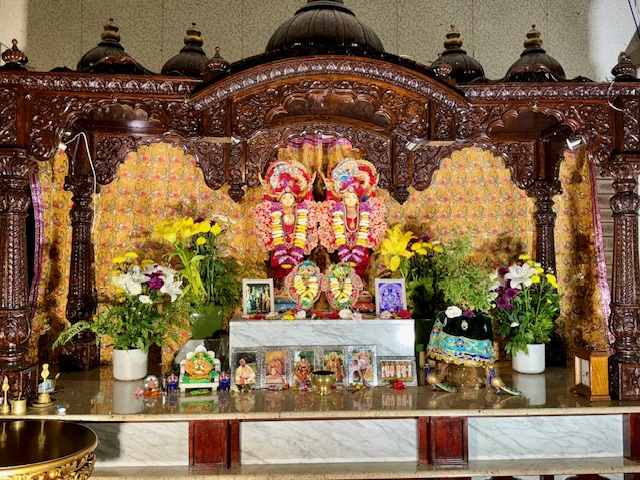
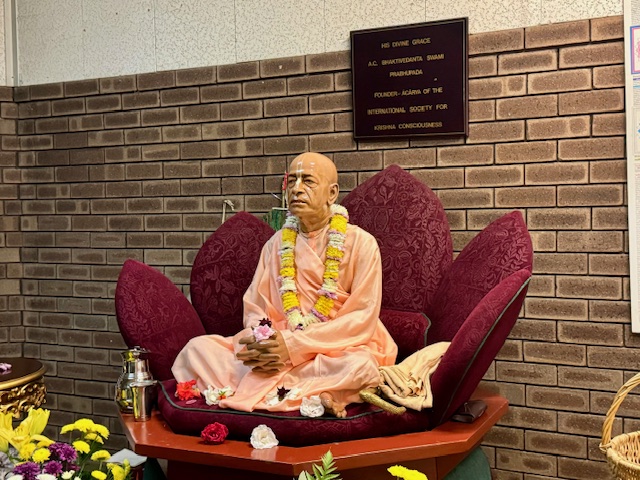
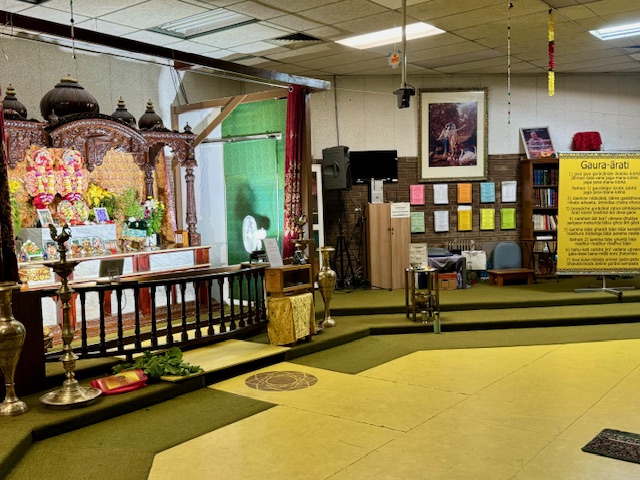
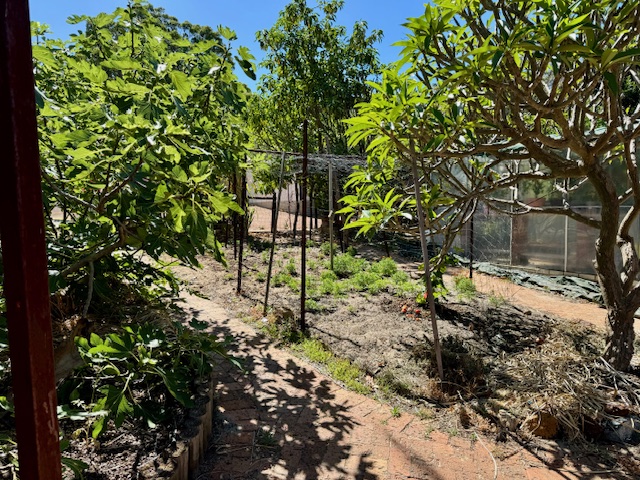
 By Vijaya Dasa
By Vijaya Dasa

